Anarchy in schools: exploring chaos and change

Anarchy in schools promotes freedom and student autonomy, allowing learners to take control of their education and fostering critical thinking and creativity while integrating modern educational trends.
Anarchy in schools raises questions about the conventional educational system. What would happen if we reimagined learning environments? Let’s dive into this thought-provoking topic.
Understanding anarchy in educational contexts
Understanding anarchy in educational contexts can reveal fresh perspectives on learning. This idea challenges us to rethink how schools function, focusing on freedom and decentralization.
Many educators are exploring this concept to create environments where students can thrive without traditional constraints. In these settings, students often have a greater voice in their education.
Key Principles of Anarchy in Education
Several core principles guide anarchistic approaches:
- Self-governance: Students participate in decision-making.
- Collaboration: Learning is centered around teamwork.
- Freedom of exploration: Students choose subjects that interest them.
- Flexibility: The curriculum adapts based on students’ needs.
The shift towards embracing anarchy in schools can be seen in various educational movements. For instance, certain progressive schools implement this by fostering trust and autonomy among students. In these environments, teachers act more as guides than authorities, allowing learners to direct their own paths.
Experiencing this form of education can be eye-opening for students. When they feel ownership of their learning, they engage more fully and creatively. This approach can also break away from restrictive standards, encouraging a love for knowledge that is often lost in traditional settings.
Challenges to Consider
While the benefits are appealing, there are challenges as well:
- Ensuring accountability: How do educators maintain standards?
- Resistance to change: Some stakeholders may prefer traditional methods.
- Resource availability: Not all schools have the means to implement such changes.
Despite these challenges, many believe that adopting anarchy in educational contexts leads to a more engaged and self-motivated student body. It’s a conversation that merits exploration, as communities seek educational methods that truly serve their students’ needs.
Historical perspectives on school anarchy
Exploring the historical perspectives on school anarchy reveals a rich tapestry of ideas that have influenced education over the years. This approach has roots that can be traced back to various educational reformers who sought to redefine learning environments.
The notion of anarchy in schools isn’t a modern concept; it has evolved through time, often intertwined with broader social movements. Many educators in the past questioned traditional authority and pushed for more democratic practices in classrooms.
Pioneering Educational Reforms
Throughout history, several key figures stand out in the fight for educational reform:
- John Dewey: Advocated experiential learning and democracy in education.
- Maria Montessori: Promoted child-centered education focused on freedom and respect.
- Paulo Freire: Emphasized critical pedagogy and dialogue in learning.
These pioneers laid the groundwork for an understanding of how anarchy could promote freedom in educational settings, allowing students to take charge of their own learning journeys. In their methods, education was seen as a collaborative process that should nurture individual potential.
As we look at various movements, we see that their influences continue to resonate even today. The free school movement, which emerged in the 1960s, echoes similar principles. Educators involved in this movement emphasized self-directed learning and the importance of community engagement.
Lessons from Past Educational Movements
The successes and challenges of earlier anarchistic educational frameworks provide valuable insights:
- Importance of trust and freedom in relationships between teachers and students.
- Flexibility in curriculum to cater to the interests and needs of learners.
- Encouragement of critical thinking and creativity over rote memorization.
Understanding these historical perspectives allows us to appreciate the evolution of education and its potential to embrace new, more liberating structures. By learning from the past, educators can continue to shape future classrooms into dynamic environments where all students thrive.
The pros and cons of anarchistic education

When discussing the pros and cons of anarchistic education, it’s essential to consider both the benefits and challenges that this approach presents. Anarchistic education encourages a learning environment where students have significant autonomy and involvement in the educational process.
One of the primary advantages is that it fosters independence among students. When learners are given the chance to make choices, they often become more motivated and engaged. This method can lead to a deeper understanding of subjects, as students select topics that genuinely interest them.
Benefits of Anarchistic Education
Here are some notable benefits:
- Empowerment: Students feel a sense of ownership over their learning.
- Creativity: The freedom to explore encourages innovative thinking.
- Collaboration: Students often work together, fostering teamwork and communication skills.
- Critical thinking: Encourages deeper questioning and understanding of subjects.
However, there are also challenges to consider. Implementing an anarchistic educational model can be difficult in settings that expect traditional structures. Some educators may find it hard to adjust their teaching styles to accommodate a less structured environment.
Challenges of Anarchistic Education
Here are some challenges that may arise:
- Accountability: Without traditional assessments, measuring progress can be tricky.
- Resistance: Some parents and administrators may oppose this approach.
- Resource limitations: Not all schools can provide the necessary resources for such a system.
Despite these challenges, understanding the balance between autonomy and structure is crucial. Educators must navigate these dynamics to create a safe space where students feel encouraged to explore while still meeting educational goals.
Case studies: schools embracing alternative structures
Several schools around the world have embraced alternative structures as a way to promote learning free from traditional constraints. These case studies show how different models of education can challenge the norm and provide intriguing results.
One noteworthy example is the Sudbury Valley School in Massachusetts. This school operates on a democratic model, allowing students to control their own learning experiences. Here, students set their own schedules and choose what subjects to study without mandatory classes. This approach fosters a sense of responsibility and independence as students learn to manage their time and interests.
Notable Schools with Alternative Structures
Here are some schools that exemplify successful alternative educational structures:
- Summerhill School: Located in England, this is one of the first schools with a democratic system where children are free to choose their activities.
- Waldorf Schools: These schools use a holistic approach, emphasizing creativity and emotional intelligence in a structured environment.
- Montessori Schools: This method focuses on child-led learning, where students engage with hands-on materials at their own pace.
The success of these schools suggests that when students are given more freedom, they often show higher levels of engagement and enthusiasm for learning. For instance, at Montessori schools, children are encouraged to explore their interests, which can lead to a lifelong love for learning. In addition, the Waldorf approach incorporates arts and movement, allowing for a well-rounded education that fosters both creativity and critical thinking.
However, embracing alternative structures does not come without challenges. Schools like these must continually adapt their methods and curricula to meet the diverse needs of students. Without a standard curriculum, educators may find it challenging to ensure that all students meet educational benchmarks.
Impact on Student Learning
The impact of these alternative structures on student learning is profound. Many students experience increased motivation and a sense of agency over their education. For example, in democratic schools, students often report feeling more valued and respected, which can translate into better academic performance and social skills.
Ultimately, these case studies highlight the potential benefits of rethinking traditional educational frameworks. By observing how different models succeed, educators can explore new ways to engage students and create more effective learning environments.
Possible future trends in educational reform
As we explore the possible future trends in educational reform, it’s important to recognize the shifting landscape of education. With advancements in technology and changing societal needs, the way we approach learning is evolving quickly.
One significant trend is the increasing integration of technology in classrooms. Blended learning models that combine traditional teaching with online resources are becoming more common. This allows students to learn at their own pace and access a wealth of information beyond the classroom.
Emerging Educational Trends
Here are some key trends that may shape the future of education:
- Personalized learning: Tailoring education to meet the individual needs and preferences of students can enhance engagement.
- Social-emotional learning: Emphasizing emotional intelligence and interpersonal skills is gaining importance in educational settings.
- Project-based learning: This hands-on approach encourages students to work on real-world problems, fostering critical thinking and collaboration.
- Global learning: Connecting students with peers around the world extends their learning experiences and cultural understanding.
Another growing area is the emphasis on mental health and well-being within schools. Recognizing that a student’s emotional state affects their ability to learn is crucial. Schools are beginning to implement support systems, such as counseling programs and mindfulness practices, to help students cope with stress and anxiety.
As society becomes more interconnected, there is also a push for education that reflects global citizenship. Teaching students about diverse cultures and global issues prepares them for the complexities of the modern world.
Technology’s Role in Education
Technology will surely play a vital role in these future trends. Tools like virtual reality and artificial intelligence could revolutionize learning experiences. Using VR, students can explore historical sites or scientific concepts in a fully immersive way, making lessons more engaging.
Moreover, AI can help tailor learning experiences by analyzing student performance and suggesting resources tailored to their needs. This technology not only aids students but can also provide teachers with valuable insights into their students’ progress.
These trends highlight an exciting shift in education. By embracing these changes, educators can create a more effective and inclusive learning environment that prepares students for future challenges.
In summary, the exploration of anarchy in schools and the shift towards alternative educational structures reveals exciting possibilities for the future. As we embrace trends like personalized learning and technology integration, education can become more engaging and relevant. Schools that utilize these innovative methods not only empower students but also prepare them for a rapidly changing world. By focusing on social-emotional learning and global citizenship, we can create environments where every student thrives. The future of education looks bright, and adapting to these changes is essential for fostering the next generation of learners.
FAQ – Frequently Asked Questions about Anarchy in Schools
What is anarchistic education?
Anarchistic education is an approach that emphasizes freedom, autonomy, and student choice in the learning process, moving away from traditional structures.
How does technology influence anarchistic education?
Technology enables personalized learning experiences and helps students engage with materials in ways that suit their interests and needs, enhancing the educational experience.
What are the benefits of alternative educational structures?
These structures encourage creativity, critical thinking, and collaboration among students, allowing for a more engaging and relevant learning environment.
What trends are gaining traction in educational reform?
Trends include personalized learning, social-emotional learning, project-based learning, and the incorporation of technology in teaching strategies.





